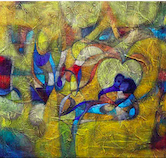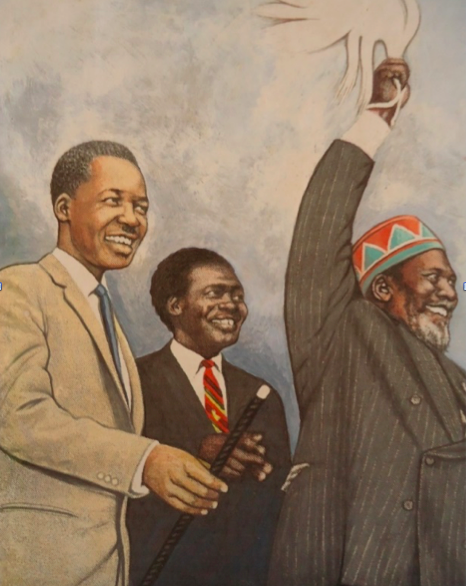Kenya, in the imagination of Western utopianists such as Theodor Hertzka, was fantasised about as an unpopulated Garden of Eden, an idyll for flora and fauna and “Freeland” as an alternative paradise. A small group of people of the so-called Freeland Association actually attempted settling in Lamu in the doomed hope to realise this utopia. Fuelled by such fin de siècle fantasies Eastern Africa became the playground of Western ‘explorers’, botanists and trophy hunters, who dismissed Kenyan farming and civilization methods, which left little marks on the land and who saw the communities as part of a ravishing scenery [FIG 02]. These attitudes were surmised by John Roberts, a British ethnomusicologist in 1967, just after independence, in his book Kenya Today, A Land full of People: “The rationale was that in 1963 or 4… Kenya was thought of as either a land full of rather alarming politics or a land full of wild animals. So the theme was that Kenya is not a land full of interesting game or of alarming politics but of people” (Stewart, 1989).
Since the beginning of Kenya’s contact with the British and German colonists in the late 19th century, Kenyan people were fashioned by Western thinkers into fundamentally ‘non-modern’ people, whose traditions were summoned as evidence of their supposed inherent inferiority. Mudimbe describes this as the colonialism of knowledge (Mudimbe 1988:5-6). Colonialist racism at the turn of the 20th century reached new extremes, which Charles Elliot, the commissioner for British East Africa (now Uganda and mainland Kenya) expressed: “His mind [The ‘African’] “is far nearer to the animal world than that of the European or Asiatic, and exhibits something of the animals placidity and want of desire to rise beyond the state he has reached.” Elliot’s sentiments were echoed by other colonialists and colonial era adventurers such as Frederick Lugard, the British governor of colonial Nigeria, and Frederick Guggisberg and Decima Moore, colonial “Gold Coast” (Ghana) administrators and travel writers, who all contributed variously to the Eurocentric invention of colonial Africans.
This background is fundamental to a wholesome understanding of the trajectories, both aesthetic and conceptual, which modern art took in Kenya after the Second World War and into the contemporary. It is important to understand that these views were not simply fringe opinions of disdain held by white colonial elites, but pervasive throughout colonial Kenyan society. This included its populations of colour, particularly Kenya’s Indian and South Asian minority and, to a certain extent, Kenyan Africans themselves, as Robert Johnson (2003:1) writes: “Africans and Asians sometimes adopted Western religion, education, or forms of behaviour if they felt it had something to offer them. They were not necessarily indoctrinated but were capable of opportunism. Yet the adoption could bring only limited advantage”.
The modern missionary movement preceded colonialism but became strongly entangled in it. Many Kenyans, especially those who belonged to sedentary agricultural communities near the colonial centres of Nairobi and Mombasa accepted Christian conversion, some grudgingly and some enthusiastically, whereas many of the Nomadic pastoralists in the Rift Valley – particularly the Maa speaking clans – utterly rejected Christian proselytising and colonial influence in general for most of the ‘Short Century’ liberation era (1945–1994).

![[FIG 01] Samuel Wanjau, Dedan Kimathi wa Waciuri, c.1970, stone sculpture, detail, courtesy of Paa ya Paa Art Centre](https://eaman.belvadigital.com/wp-content/uploads/2024/09/FIG-01_02_Samuel-Wanjau_Dedan-Kimathi_detail_1970s_Courtsey-Paa-y-Paa-Art-Centre.jpg)
![[FIG 02] Lamu, ca 1880, by C.S.Joux, Lake Victoria](https://eaman.belvadigital.com/wp-content/uploads/2024/09/FIG-02_02_Lamu_Hertzka_Lake-Victoria.jpg)
![[FIG 03] A Turkana herdsman driving his stock on a return journey to Northern Kenya from Uganda](https://eaman.belvadigital.com/wp-content/uploads/2024/09/FIG-03_02_A-Turkana-herdsman-driving-his-stock-on-a-return-journey-to-Northern-Kenya-from-Uganda.jpg)
![[Fig 04] Maasai Morans adorned with beaded necklaces, Maasai shukas and red ochre paint](https://eaman.belvadigital.com/wp-content/uploads/2024/09/FIG-04_02_-Maasai-Morans-adorned-with-beaded-necklaces_Maasai-shukas-and-red-ochre-paint-1.jpg)
![[FIG 05] Maasai elders and young initiates during Enkipaata, copyright Danson Siminyu, Kenya, 2017, Source: Unesco](https://eaman.belvadigital.com/wp-content/uploads/2024/09/FIG-05_02_Enkipaata_2017.jpg)
![[FIG 06] Theresa Musoke, Cat Ghosts, 1960's, Oil on board, Courtesy the artist and Makerere Art Gallery Collection](https://eaman.belvadigital.com/wp-content/uploads/2024/09/FIG-06_02_Theresa-Musoke_Cat-Ghosts_1960s_Oil-on-board_-Courtesy-the-artist-and-Makerere-Art-Gallery-Collection.jpg)
![[FIG 07] Meek Gichugu, No Erotic they say, c.1992, oil on canvas, courtesy the artist and Nairobi Contemporary Art Institute](https://eaman.belvadigital.com/wp-content/uploads/2024/09/FIG-07_02_Meek-Gichugu_No-Erotic-they-say_1992_oil-on-canvas_Courtesy-the-artist-and-Nairobi-Contemporary-Art-Institut.jpg)
![[FIG 08] Brian Kimani, Main Stage 1, 2024, acrylic on canvas, courtesy of the artist.](https://eaman.belvadigital.com/wp-content/uploads/2024/09/FIG-08_02_-Brian-Kimani_Main-Stage-1_2024_acrylic-on-canvas_Courtesy-of-the-artist.jpg)
![[FIG 09] Traditional Kisii Utility items, courtesy of John Akama](https://eaman.belvadigital.com/wp-content/uploads/2024/09/FIG-09_02_Traditional-Kisii-Utility-items_Courtesy-of-John-Akama.jpg)
![[FIG 10] Mutisya Munge, Askari Figurine, c.1920, wooden sculpture, courtesy of Michael Stevenson Gallery](https://eaman.belvadigital.com/wp-content/uploads/2024/09/FIG-10_02_-Mutisya-Munge_Askari-Figurine_circa-1920_wooden-sculpture-_Courtesy-of-Michael-Stevenson-Gallery.jpg)
![[FIG 11] Unnamed Akamba artist, Askari Figurine, undated, wooden sculpture, courtesy of Bruno Claessens](https://eaman.belvadigital.com/wp-content/uploads/2024/09/FIG-11_02_Unnamed-Akamba-artist_Askari-Figurine_-undated_wooden-sculpture-Courtesy-of-Bruno-Claessens.jpg)
![[FIG 12] Ujaama ‘Tree of Life’ Sculpture, undated](https://eaman.belvadigital.com/wp-content/uploads/2024/09/FIG-12_02-Ujaama-Tree-of-Life-sculpture-_Makonde-Scultpure_Tanzania-1960s.png)
![[FIG 13] Samuel Wanjau, Dancing Warrior, 1978, Tropical hardwood, 260 x 31 cm](https://eaman.belvadigital.com/wp-content/uploads/2024/09/FIG-13_02_samuel-wanjau-dancing-warrior_1978.jpg)
![[FIG 14] Samuel Wanjau, Untitled, c.1980](https://eaman.belvadigital.com/wp-content/uploads/2024/09/FIG-14_02-Samuel-Wanjau-Untitled-c.1980-.jpg)
![[FIG 15] Samuel Wanjau, Dedan Kimathi wa Waciuri, c.1970, stone sculpture, courtesy of Paa ya Paa Art Centre](https://eaman.belvadigital.com/wp-content/uploads/2024/09/FIG-15_02_Samuel-Wanjau_Dedan-Kimathi-wa-Waciuri_c.1970_stone-sculpture_Courtesy-of-Paa-ya-Paa-Art-Centre.jpg)

